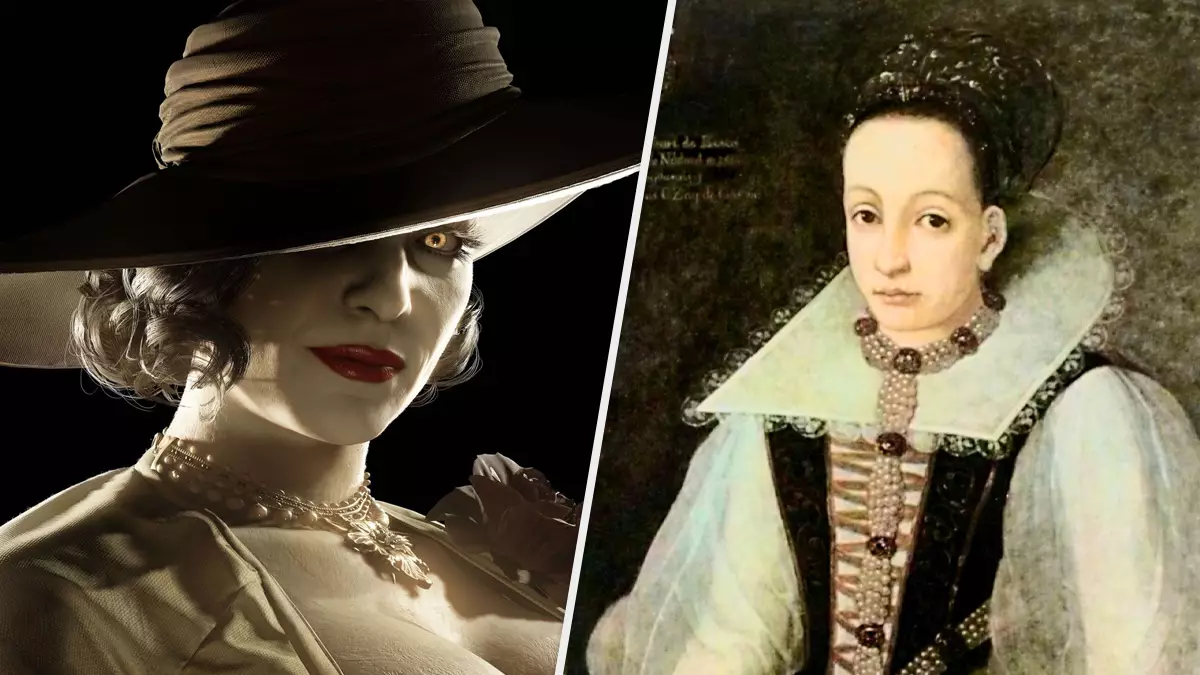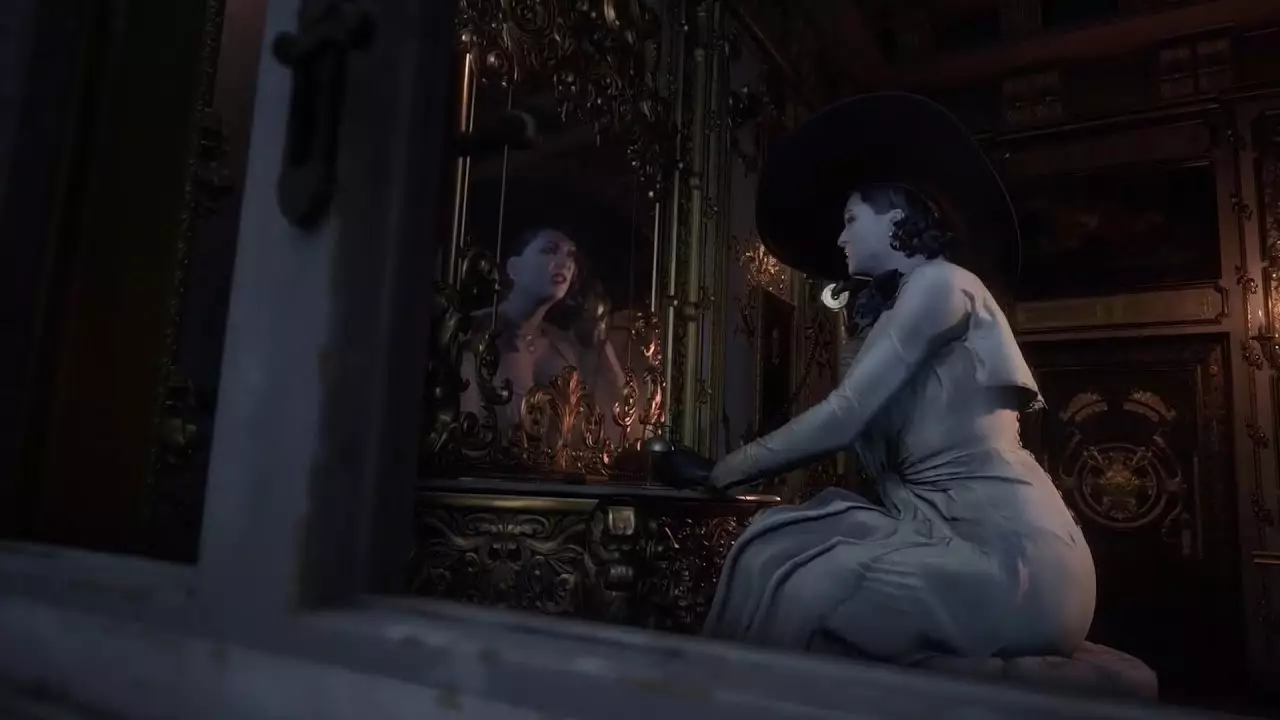
It wouldn't be hyperbole to say that Lady Dimitrescu is the shining star of Resident Evil Village. One of the Four Lords who follow Mother Miranda, she towers over the rest of the cast and clearly considers herself and her daughters above the squabbles of Heisenberg, Moreau, and Angie. Lady Dimitrescu's presence isn't one to ignore, either - even though her arc is contained to the early hours of the game, the character has dominated social media and captured the hearts of those who've experienced the horrors that Village has to offer. Love her or loathe her, her impact isn't to be diminished irrespective of where you stand. But, did you know that Lady Dimitrescu is inspired by a real serial killer from the medieval times?
Spoilers for Resident Evil Village will follow as I refer to events and writings about Lady Dimitrescu as well as historical sources. Check out our video review of the game here, where Mark delves into the way the game pays tribute to its earlier entries and pushes the envelope elsewhere.
Advert
Before we get going, let's cover the basics. With noble roots to the village, Alcina Dimitrescu was subjected to Mother Miranda's experiments with the Cadou as the scientist searched for an appropriate host for her child to be resurrected into. Ultimately, Alcina's transformation was not what Miranda required, however, she gained abilities like incredible regeneration, immortality, razor-sharp retractable talons, and the ability to turn into a dragon-like creature. Superficially, I'll admit that there aren't a lot of similarities with a real human being thus far. The devil is in the details, though, so stay with me.
Her name was Countess Elizabeth Báthory de Ecsed, or Báthory Erzsébet in Hungarian, though we'll call her Elizabeth for short. Born in 1560 in the Kingdom of Hungary, Elizabeth's intelligence and her beauty preceded her, and she spoke four languages including Greek and Latin. Inbreeding was a common practice of European nobility, and she suffered seizures that may have been triggered by genetic defects as her parents were both Báthorys too. At the age of 15, she married Count Ferenc Nádasdy, yet she did not assume his surname as she was of a higher social standing than her husband. Five children were born, according to official records, and while Nádasdy was away aiding the war effort, Elizabeth was in charge of the castle and managing the impact of the conflict on the lower classes.

She seems like any other noblewoman in medieval Europe, doesn't she? Here's where the story goes off the rails. Over the course of two decades, Elizabeth killed hundreds of girls and women, as per the testimonies of over 300 witnesses and survivors. One novelist said she was "not simply a murderess, she was a murder factory," so that's the scale of what we're talking about. Records of the torture of her victims - which were facilitated by four servants - were an abhorrent abuse of power. Following her husband's death, Elizabeth's income saw a sharp decline, so she offered families the opportunity to educate their daughters in the pursuit of propriety and decorum, for a fee.
Advert
What happened instead were severe beatings; burning or mutilation of hands; biting the flesh off faces, arms and other body parts; freezing or starving to death; use of needles; burning with hot tongs and then dousing in freezing cold water; coating in honey and ants; and even cannibalism. The bodies piled up and servants could no longer hide the atrocities committed behind closed doors - tragically, it was only when the daughters of the lesser gentry went missing that the investigations started. Wildly enough, Elizabeth never received a trial and her punishment was to be restricted to house arrest in her own castle, where she died of heart failure at the age of 54.

There's an incalculable amount of mythologisation around Countess Elizabeth Báthory, owing to a lack of official information on her crimes and the deviance of her killings. "Unlike other female killers, she did not kill as a result of revenge, money, or 'battered wife syndrome,'" explains Rachael Leigh Bledsaw in their thesis. "Her more hands-on, physically violent style has much more in common with male twentieth century serial killers than with fellow female serial killers." Even after Elizabeth's passing, her name was not to be spoken in the country for over a century. As the story spiralled out of the hands of the noble houses, rumours swirled that she was a creature that thirsted for and bathed in the blood of virgins, eager to cheat death and vain beyond belief.
A vampire. In other words. Of course, she wasn't, but our Alcina Dimitrescu absolutely was. As a result of her hereditary blood disorder, Alcina needed to consume human blood to prevent a spontaneous transformation into her dragon form and maintain her regenerative abilities. Treatment for Elizabeth's epilepsy would have involved wiping the blood of a non-sufferer on her lips, or imbibing a mix of the blood of a non-sufferer and a piece of their skull. Exploring the depths of the castle, Ethan encounters Moroaică who are the remnants of the prisoners that Alcina drained for her wine, the eerily named Sanguis Virginis. Alcina was also incredibly intelligent, like Elizabeth, and the latter's crimes have been theorised to be sparked by the difference between herself and her contemporaries. Bledslaw uses a brilliant metaphor here which I will relay for you: "this education made her keenly aware that while she might have been the brightest crayon in the box, so to speak, she was still a secondary colour." Out of frustration, she took out her emotional state on those who couldn't fight back and couldn't speak out.
Advert

The player sees this frustration replicated in the fictional character, where Alcina holds Mother Miranda in high esteem and wishes that she would recognise this devotion. She butts heads with Heisenberg, and the shuffling Moreau and squeaks of Angie appear to not affect her at all. Furthermore, as Elizabeth was aided by her accomplices, Alcina was granted the Cadou to create Bela, Cassandra and Daniela - her daughters. Historians had previously used Elizabeth's letters to her husband, detailing their children's health and not their adventures or personalities, as evidence of a cold and unavailable mother. Yet, nobility were keenly aware that human hands were much more responsible for the health of others than random chance, and though they are experiments and recorded as such (Bela, Cassandra, and Daniela), Alcina flies into a rage discovering that Ethan has killed them.
Of course, this isn't the only source that inspired Capcom when designing Lady Dimitrescu, and it cites the urban legend Hasshaku-sama for her height and her remarkable wide-brimmed hat. However, it intrigued me that the character is likely to be one of the more sympathetic interpretations of Elizabeth in spite of her horrific history, and that there were plenty of parallels to draw between the two women. "Giant vampire wife" is a way to describe her, yes, as is "complex and powerful victim," as is "sadistic villain," as is "insecure and ill-favoured individual out of her depth." Lastly, it shows that referring to historical records with regards to game writing might offer us insights into the past and a greater depth of characterisation in the medium.
Featured Image Credit: Capcom, Interfoto/AlamyTopics: Features, Resident Evil, Resident Evil Village, Capcom